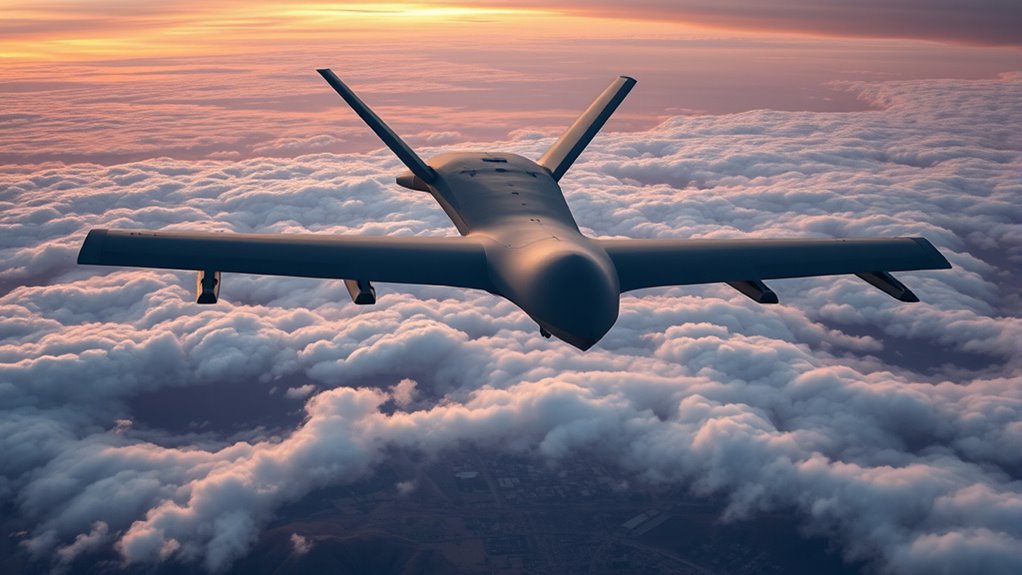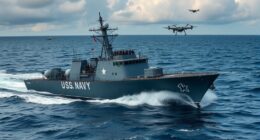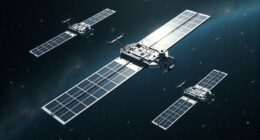Air Force ISR systems serve as the guardians of the high frontier, providing you with real-time intelligence critical for national security. These advanced satellites capture images, signals, and sensor data from space, enabling continuous surveillance of military movements and threats. Analysts interpret this vast information using sophisticated algorithms and human expertise to turn raw data into actionable insights. If you want to discover how these technologies keep our skies safe and maintain dominance, keep exploring further.
Key Takeaways
- The Air Force’s ISR systems provide continuous, high-altitude surveillance to safeguard national security and monitor global activities.
- Advanced sensors and analysis platforms transform raw satellite data into actionable intelligence for strategic decision-making.
- ISR operations support real-time threat detection, military movements tracking, and defense of air and space domains.
- Cutting-edge technology and human expertise ensure high-quality data collection and accurate interpretation of complex information.
- Maintaining dominance in space and air is essential for operational effectiveness and safeguarding national interests.

Have you ever wondered how the Air Force gathers critical intelligence to maintain national security? It’s a complex process that involves cutting-edge technology and meticulous analysis. At the core of this effort are satellite surveillance systems, which provide a bird’s-eye view of global activities. These satellites orbit high above the Earth, capturing images and signals that would be impossible to obtain from the ground. They monitor military movements, track potential threats, and gather essential information about regions of interest. But simply collecting data isn’t enough—what truly makes these systems powerful is data analysis. Once the satellite data is received, specialized analysts sift through vast amounts of information to identify patterns, anomalies, and actionable insights. This process transforms raw satellite imagery and signals into intelligence that decision-makers rely on to protect the nation.
When you think about satellite surveillance, you should recognize how it operates as a persistent eye in the sky. It’s not just about taking pictures; it’s about continuous, real-time monitoring that can alert the Air Force to emerging threats or changes on the ground. These satellites are equipped with advanced sensors capable of capturing different types of data—visual, infrared, radar—making them versatile tools for various missions. The data they collect is then funneled into sophisticated analysis platforms. Here, algorithms and human expertise combine to interpret what the satellite images mean. This integration of technology and analysis enables rapid decision-making, which is critical in high-stakes situations. Additionally, the effectiveness of satellite surveillance relies heavily on advanced sensor technology, which enhances the quality and variety of data captured in space.
You also need to understand that satellite surveillance and data analysis are intertwined processes. The effectiveness of one depends on the other. Without high-quality satellite data, analysis becomes guesswork. Conversely, without skilled analysts and advanced processing tools, the raw data remains useless. The Air Force invests heavily in both areas, constantly upgrading satellites and honing analytical capabilities. This synergy ensures that intelligence is accurate, timely, and relevant. It’s this combination that allows the Air Force to maintain dominance in the high frontier of space and air, providing strategic advantages that keep the nation safe. So, next time you hear about satellite surveillance, remember it’s not just about high-tech gadgets orbiting above; it’s about a dedicated effort to turn space-based images into actionable intelligence—an essential part of the Air Force’s mission to defend and secure the nation.
Frequently Asked Questions
How Do Air Force ISR Assets Coordinate With Other Military Branches?
You coordinate Air Force ISR assets with other military branches through interagency collaboration and joint operation protocols. By sharing real-time intelligence, conducting joint planning sessions, and utilizing interoperable communication systems, you guarantee seamless integration. This collaboration allows all branches to synchronize efforts, enhance situational awareness, and respond quickly to threats. Regular training exercises and established procedures maintain effective coordination, making your combined operations more efficient and impactful.
What Are the Future Technological Advancements in ISR Capabilities?
You’ll likely marvel at how space-based sensors and AI integration transform ISR. These advancements enable real-time data processing and unprecedented global reach, making traditional reconnaissance seem primitive. Ironically, as tech gets smarter, the battlefield demands even quicker decisions. Future ISR capabilities will harness AI to analyze massive data streams instantly, while space sensors provide eyes everywhere—turning the high frontier into an even more high-stakes arena for intelligence dominance.
How Is Data Security Maintained During ISR Operations?
You guarantee data security during ISR operations by implementing strong encryption protocols that protect sensitive information during transmission and storage. Additionally, you rely on robust cyber defense measures to detect, prevent, and respond to cyber threats. Regular updates and monitoring keep systems secure, while access controls limit data exposure. This layered approach helps maintain the integrity and confidentiality of ISR data, safeguarding national security interests effectively.
What Training Is Required for Personnel Operating ISR Systems?
You need specialized training in intelligence analysis and satellite operations to operate ISR systems effectively. This includes understanding data collection, analysis techniques, and secure communication protocols. You’ll undergo rigorous classroom instruction, hands-on simulations, and real-world exercises to sharpen your skills. Continuous learning is essential, so you stay updated on evolving technology, cybersecurity measures, and mission-specific tactics. Ultimately, your training guarantees you can manage sensitive data securely and support crucial ISR missions effectively.
How Does ISR Impact Strategic Decision-Making Processes?
Did you know that 80% of strategic decisions depend on intelligence analysis? ISR substantially impacts strategic decision-making by providing real-time data that shapes operational planning. It enables you to assess threats accurately, allocate resources efficiently, and anticipate adversary moves. This rapid, precise information streamlines decision processes, ensuring you can respond swiftly and effectively in complex scenarios, ultimately strengthening national security and operational success.
Conclusion
So, next time you marvel at sci-fi movies, remember, real-life guardians of the high frontier are silently watching from the skies, making sure extraterrestrial invasions stay fictional. You might think you’re the master of your universe, but the Air Force ISR is busy mapping the cosmos while you’re busy binge-watching. Without them, your daily life would be a lot less secure—and a lot more paranoid. Cheers to the unseen heroes keeping us all comfortably clueless!









